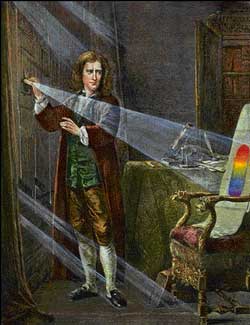Why Isaac Newton is the Greatest Physicist of All Time
An intro to Newton’s discoveries – all before the age of 26!
Isaac Newton Videos
Early Life
Sir Isaac Newton was born in the county of Lincolnshire, England in 1643. His father died just months before he was born, and when he was three years old, his mother left him in the care of his grandmother. Isaac was always a top student, and went off to the University of Cambridge at age 19. While at Cambridge, Newton was influenced by the writings of Galileo, Nicholas Copernicus, and Johannes Kepler. By 1665, Newton began developing a mathematical theory that would lead to the development of calculus, one of the fundamental branches of mathematics.
Newton would go on to discover other important math theories such as Newton’s Identities, and Newton’s Method.
Newton’s Work with Optics

Optics: a branch of physics which involves the behaviour and properties of light,
In 1670, Newton moved on to the study of optics and developed theories relating to the composition of white light and the spectrum of colors. In one of his famous experiments, he refracted white light with a prism, resolving it into its constituent colors: red, orange, yellow, green, blue, and violet. As a result of his experiments, he developed Newton’s Theory of Color, which claimed that objects appear certain colors because they absorb and reflect different amounts of light.
Newton was the first scientist to maintain that color was determined solely by light, and his findings created much controversy. Most scientists thought that prisms colored light. Nevertheless, Newton then created the world’s first color wheel, which arranged different colors around the circumference of a circle.
He is also credited as the first scientist to explain the formation of a rainbow – from water droplets dispersed in the atmosphere.
Discovering Gravity
In 1679, Newton continued his work on gravitation and its effects on the planets. In 1687, at the age of 44, he published Philosophiae Naturalis Principia Mathematica. In this landmark work, Newton explained his three laws of motion, which included his theory on gravity. According to Newton, gravity is the reason that objects fall to the ground when dropped. Moreover, gravity is the reason why planets orbit the sun, while moons orbit planets, and why ocean tides exist.
Newton’s theories remain among the most important concepts in the history of science. There is some evidence that Newton’s ideas concerning gravity were inspired by apples falling from trees. There is no evidence to suggest, however, that any of the apples hit him in the head (as cartoons and fables suggest).
Isaac Newton’s Three Laws of Motion:
- Newton’s First Law ( Law of Inertia) states that an object at rest tends to stay at rest and that an object in uniform motion tends to stay in uniform motion unless acted upon by an external force.
- Newton’s Second Law states that an applied force on an object equals the time rate of change of its momentum
- Newton’s Third Law states that for every action there is an equal and opposite reaction.
Following the publication of his work, Newton became instantly famous throughout Europe.
Later Years
In the later years of his life he wrote several articles on interpretation of the bible.
He was also appointed a member of the British Parliament and spent many years reforming the Royal Mint (coin making agency of Parliament).
He died on March 20, 1727.
